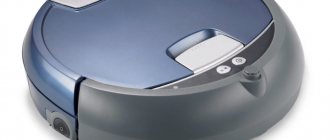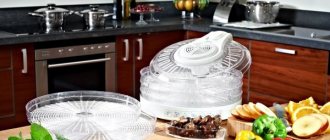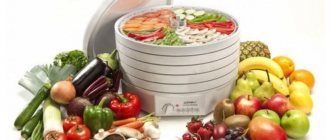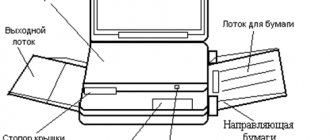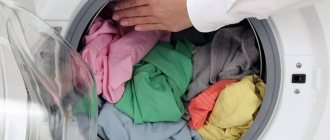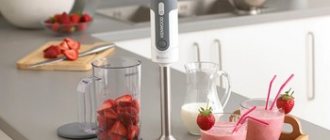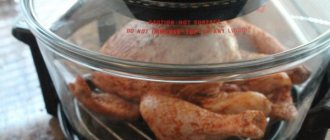The question of which dryer to choose for vegetables and fruits is especially relevant in the autumn. When there is a lot of harvest and you want to make more reserves for cold times.
The dryer will also be useful in another season, because it is perfect for any plant products. Its design is designed in such a way that the product is dehydrated while retaining its beneficial qualities - vitamins, etc.
In this review, we will talk about how to choose the right dryer for vegetables and fruits, based on its design, types and characteristics.
What types of dryers are there?
The process of processing raw materials in a dryer for vegetables and fruits affects which one to choose:
- Convective.
- Infrared.
A convection dryer operates simply and is less expensive than infrared models. It has a heating element and a fan that circulates the heated air, which in turn draws water out of the food.
Also read: Simple tips for choosing an iron for your home
There are other models - without a fan with natural convection, but in them the processing process is longer. If a model with a fan has a day, without it it can take several days, depending on how much water is in the product.
If you choose a convection dryer for fruits and vegetables, be aware that the food may become covered with a film. But they are completely usable.
An infrared dryer acts on raw materials with infrared rays. They penetrate the product by 6-12 mm and arrange its molecules differently.
Water drains quickly at 40-60 degrees. But at the same time, the product remains healthy, contains vitamins, minerals, and does not change its color or taste.
Criteria for choosing a household appliance
When choosing this technique, you need to take into account several important indicators. The choice may be influenced by the cost of the dryer, power, volume and additional features.
READ ALSO: Why do you need a virtual number service?
How to choose a dryer for vegetables and fruits? Price is not a determining factor in choosing a device. If the dryer will not be used often, then there is no need to purchase a powerful unit with many additional options. Expensive, spacious models are suitable for farms that plan to use them regularly and for a long time.
Volume and dimensions
This is one of the main criteria that you need to rely on when choosing a dryer. The manufacturer does not always indicate the volume, so you have to rely on the dimensions of the device. You need to look at the dimensions of the dryer, the number of trays and whether they are enough to dry the required amount of food for the family.
Vegetables and fruits should only be dried fresh, and the dehydration process takes 3-10 hours. It is not advisable to buy a very small dryer if there is a large amount of food to be processed. For example, 10 kg of apples cannot be dried in a 10 liter device in 1 day; a larger volume is needed. The larger the usable area, the more vegetables and fruits can be dried at one time.
Trays and number of sections
First of all, you need to pay attention to the number of sections. The more there are, the greater the volume of products that can be dehydrated. The height of the trays is also taken into account. Although high sides do not mean thicker cuts of food, they do increase the clearance, which helps speed up the process.
Sections must be removed. Thanks to this, you can complete exactly as many sections as there are enough products for. There are models of electric dryers in which the height of the trays can be adjusted. Higher sections are suitable for drying vegetables and fruits. You can even dry them whole in them.
Appliances with metal trays are more expensive than those with plastic ones. In addition, sometimes plastic can emit an off-odor that will be noticeable on dried food. But, according to customer reviews, metal trays do not always heat up evenly. They also don't provide an overview. Thus, it is better to opt for models with plastic sections. It's both cheaper and more convenient. You definitely need to check the quality of the material.
Power and temperature
Electric dryers come with a power of 200-1000 W. For home needs, the optimal option is 350-600 W. When focusing on the power of the device, it is important to take into account the volume of dried products. Models from 450 W are suitable for large families where they dry a lot of food.
READ ALSO: Emergency lock opening service
It is better to dry fruits and vegetables at low temperatures. This will retain maximum nutrients in them. Devices with a power of about 1000 W and a temperature of 60-80 ° C are more suitable for drying meat and fish. Additionally, you need to evaluate the possibility of temperature control. After all, it should be different for different types of products.
Heater type
Dryers are divided into those that operate on a heating element using convection and on an infrared heater. The latter are more expensive, but their use makes it possible to preserve maximum nutrients in products. They also almost completely retain their freshness. Dryers with heating elements are cheaper, but the quality of the dried products will be different. The advantage of dryers with heating elements is that they are able to dry even large pieces. Infrared heaters cannot do this. It is good that the dryer has a fan. It is better if the heating element and fan are placed at the top.
Extra options
Some nuances that play an important role in operation should also be taken into account when choosing a dryer. The auto shutdown function regulates the shutdown of equipment in case of overheating or short circuit in the network. A timer is necessary to set a specific time for drying food. Many people take into account the noise level of the dryer when choosing. The noise intensity increases when the fan is running. It is better to choose a device with minimal noise. The thermostat makes it possible to regulate temperature conditions. This is very convenient for drying different types of products.
Design of dryers for vegetables and fruits
To choose the right dryer for vegetables and fruits, it is worth understanding how it works.
Let's look at the main elements:
- Without the heating element, the dryer would definitely not be able to function; it is this element that provides hot air. The number of heating elements varies. If the dryer has a fan, there is only one. If it is not there - two. The heating element is located at the top or bottom of the structure.
- Thanks to the engine, the heating element and other elements work.
- The thermostat makes it possible to set degrees and keep them at the same level. Sometimes, for the comfort of users, manufacturers show temperature levels.
- The fan distributes warm air.
- The tray resembles a plastic plate with holes at the bottom through which air flows to the top. There can be five or more plates.
- The kit also includes a plastic lid covering the tray. It has a hole at the top through which steam escapes.
The presence of other elements determines which fruit and vegetable dryer you choose. There is often a timer showing the process time.
Summary: how to choose an electric dryer for vegetables and fruits
The simplest and most optimal method for choosing an electric dryer is the following:
- Determine the budget. If it is more than 10 thousand rubles, you can safely choose a model with horizontal trays. If less, then with a vertical one;
- Determine productivity. If you plan to dry no more than a few kilograms of food per week, a model designed for 500-600 W is suitable. But to process the entire harvest of apples from grandfather’s dacha, a dryer with a capacity of 1 kW or more is intended;
- Determine the type of products that you plan to process in the dryer. If you want to simultaneously dry several products with different flavors or prepare marshmallows, you will need a model with horizontal trays. Otherwise it will work with vertical;
- Determine the importance of preserving vitamins. If it is critical, you need an infrared dryer. If not, convection will do.
- A tablecloth dryer is only suitable for very small quantities of processed products.
- After determining the type and power, you can pay attention to other characteristics of the device.
Characteristics of dryers for vegetables and fruits
When choosing a good dryer for fruits or vegetables, you should pay attention to the following characteristics:
- Power . It affects how quickly fruits or vegetables are processed. The more powerful it is, the faster the dryer works, but at the same time it consumes more electricity. If you don’t plan to make workpieces often and your family is small, a model up to 350 W will be enough. When the family is larger, they make more supplies, and a dryer of up to 450 W is needed. Everything above is worth buying for someone who prepares not only for themselves, but also for sale, or shares with relatives.
- heating element. When choosing a dryer for vegetables and fruits, it is important to find out about the heating position. It can be located on the side, at the top of the structure (the best option, since water does not reach the heating, but such drying is more expensive), at the bottom of the structure (less practical, since water flows down and can damage the heating element).
- Air circulation . It can be forced or natural. In the first case, the fan runs, so the evaporation process itself occurs faster. But the beneficial properties of the raw materials are preserved. Natural circulation for those dryers that do not have a fan. Products will take longer to process.
Also read: How to use a gas stove correctly: user guide
- Number of pallets . The capacity of the dryer is judged by the pallets, so it is also important to take it into account when deciding which one to choose. If you are planning large workpieces, buy the model with more pallets. Usually there are about 5 pieces.
- Loading . This is a characteristic that indicates how many products can be processed at a time. As a rule, one plate can hold 1 kg.
- Products. When choosing a good dryer, keep in mind that you can process not only fruits and vegetables, but also fish, mushrooms, cereals, nuts, herbs and flowers.
To better understand the set of characteristics and choose a dryer for vegetables and fruits, read user reviews
Types of dryers for fruits and vegetables and their characteristics
Dryers for vegetables and fruits differ in a number of features and characteristics depending on the price segment, model and manufacturer.
By drying method
Based on this feature, four types of devices are distinguished:
- heating. They are the cheapest in the line. They are equipped with a tubular electric heater (TEH), through which the product is dried. The main disadvantages of this type of dryer are very high energy consumption and deterioration in the flavor and aromatic qualities of the finished product due to insufficient circulation during the dehydration process;
- convection In addition to the heating element, the design of convection dryers includes a fan that provides convection of warm air masses in the volume necessary for the favorable drying process. Convection dryers are versatile. Fruits and vegetables dried in them have a natural taste. The disadvantage is the high energy consumption;
Convection dryers for fruits and vegetables are the most common - tablecloths-dryers. Tablecloth dryers are a cheaper and simpler analogue of infrared electric dryers. In this case, the infrared wave emitter is mounted in a soft mat, on top of which the included grid is placed to prevent sticking. The disadvantages of this type of dryer are low efficiency and excessive process duration. In addition, drying products that oxidize due to the interaction of oxygen (apples, etc.) on a tablecloth-drying rack will be difficult;
Tablecloth dryer is the least energy-intensive - infrared. They are the most expensive and the dehydration process with their help takes a long time. But they guarantee the most gentle drying while preserving vitamins and beneficial elements, natural appearance and flavoring qualities in the finished product.
Infrared dryers tend to be more expensive than others
By power
The power level of the dryer affects the drying speed of the product and the amount of electricity consumed. The power rating for dryers varies from 165 to 1000 W. Depending on the set of products that are supposed to be dried, the following devices are recommended:
- 165–350 W is the power indicator required for preparing herbal preparations, finely chopping fruits and vegetables, etc.;
- 350–500 W - a sufficient level of power for drying products of plant origin (fruits, vegetables, mushrooms, etc.);
- 600–1000 W is the required power for drying fish and meat.
A higher power rating is also typical for the most productive models.
According to the material of manufacture
The body of electric dryers can be made of:
- metal;
- plastic: transparent;
- opaque.
Table: advantages and disadvantages of metal and plastic dryer bodies
| Frame | Advantages | Flaws |
| Metal | impact resistance | heating the structure from the outside; the likelihood of overdrying the product due to heating the metal; Difficult to care for (difficult to wash). |
| Plastic | cheapness; light weight; ease of care (washing). | in the case of low-quality plastic, deterioration in the taste of the finished product; instability to mechanical damage. |
The transparent body simplifies visual monitoring of the process, eliminating unnecessary disassembly of the structure. Many metal dryers have transparent doors for this purpose.
By number and depth of trays
The permissible volume of products and the number of their types for simultaneous drying depend on the number and depth of the trays. On average, the device accepts from 3 to 15 pallets. The depth of the trays can be:
- standard - from 3 to 10 mm (designed for drying product cut into medium pieces);
- high - more than 15 mm (presumably drying the whole product: mushroom, apple, etc.);
- flat in the form of a mesh sheet (for drying small products: herbs, berries, etc.);
- thin in the form of a continuous tray (optimal for making marshmallows).
By tray location
Depending on the location of the trays, dryers are distinguished:
- with vertical arrangement. More common. The heating element of vertical dryers is located either above the trays or, and this is more common, below them. Air circulation, accordingly, is also carried out vertically. The main disadvantage of such dryers is the need to disassemble the structure and rearrange the pallets in order to ensure uniform dewatering. But these electric dryers are compact and are in the middle price segment. In addition, the vertical arrangement of the trays allows you to change their number depending on need;
- with horizontal arrangement. They are less common. The heating element in them is located in one of the walls of the housing and the heated air moves horizontally. This eliminates the possibility of mixing odors of different products during processing. The design feature of dryers with horizontal trays provides equally convenient access to all pallets. The main disadvantage of such models is their high cost.
Dryer with horizontal trays provides equal access to all trays
By type of control
Electric dryers are classified according to the type of control:
- mechanical;
- electronic.
The mechanical control panel is reliable and easy to operate.
Mechanical control panel is traditional
The electronic control panel is more informative due to the presence of an electronic display on which the specified parameters are displayed.
Electronic control panel displays set parameters
By number of operating modes
The main and most common operating modes of dryers are:
- 30–35 °C (drying herbs and small slices);
- 50–55 °C (drying vegetables);
- 55–60 °C (fruit drying);
- 70 °C (drying meat and fish).
According to the availability of additional functions
Additional functions that do not affect the essence and quality of the main work, but, as personal experience shows, facilitate the operation of the device and make it more comfortable are:
- built-in thermostat (will ensure maintaining a constant temperature);
- supply of cold air (will eliminate the possibility of overdrying the product);
- timer (guarantees the device turns off at the required time);
- backlight (will simplify monitoring of the process);
- protection against overheating (will extend the life of the device).
By manufacturer
Currently, there are many manufacturers of electric dryers.
Table: the best manufacturers of dryers for fruits and vegetables in different price segments
| Dryer price category | The best manufacturer in the price segment | Main characteristics |
| Budget (≈up to 3000 rub.) | Supra (PRC); "Rotor" (Russia); "Sukhovey" (Russia) | Plastic case, mechanical control, high trays. There is no timer. Disadvantage: long drying time. |
| Average (≈up to 15,000 rub.) | Tefal (France); Scarlet (UK); Polaris (Italy); VolTera (Russia) | There is a timer, an electronic control panel, and overheat protection. Powerful fan, high drying temperature, large capacity. |
| Premium (over RUB 15,000) | Rommelsbacher (Germany); Ezidri (New Zealand); Rawmid (PRC) | Low electricity consumption, high power, there is a thermostat. There is a display and a timer. Trays made of durable plastic. The disadvantage is the large weight of the structures. |
Additional characteristics of dryers
The presence of additional functions determines the model of fruit and vegetable dryer you choose.
Manufacturers offer:
- Air speed regulator. With its help, you can adjust the circulation speed, focusing on the raw materials and their weight.
- Timer. Using it, you set the operating time of the device, that is, you can say “stop the process” after a certain hour.
- Auto power off. A safety function that turns off the device if there is a risk of overheating. This increases the service life of the heating element.
- Indication . As a rule, there is electronic control. Allows you to see the time, temperature on the panel. The mechanics have a light bulb instead.
Where can I buy
You can purchase a dehydrator for vegetables and fruits from the official manufacturer, in a hardware store or a household goods hypermarket (the links below lead directly to the selections - open and look):
- AliExpress – largest selection, 985 dehydrators. The search selection sometimes includes “junk” products - enable sorting by price, then only dryers will be at the beginning of the selection.
- Eldorado – products starting at RUB 1,270.
- Citylink – 51 products in stock, starting from RUB 1,480.
- Yulmart – 15 products, from 1600 rub.
Polaris PFD 2705
- Power: 540 W
- Number of pallets: 5
The model from Polaris has a square shape and matching trays. Racks measuring 32x32 cm will accommodate more food than round ones with the same diameter. There are five pallets here - this is enough for preparing dried vegetables and fruits at home.
The power of the model reaches 540 W. Control is carried out using a round mechanical knob - you can accurately set the operating temperature from 35 to 70°C. It’s convenient that the dryer comes with detailed instructions, which describe what temperature conditions are best to choose for cooking different foods.
At the bottom of the dryer body there is a cable channel for the network cable. The trays are made of transparent plastic and are dishwasher safe. You can buy the Polaris PFD 2705 model for an average of 4,000 rubles.
Recommendations for selection
It is important that the model is not only roomy, but also lasts a long time and dries food efficiently!
Some tips will help you choose the best dehydrator for vegetables and fruits:
- Please note the model's capacity . You may not want a model that is too big. A classic dryer with 5 trays is designed to meet the needs of an ordinary family and can process several kilograms of raw materials in one go.
- Do not purchase a model with very low power . You can only cook chips in it. For more serious processing, the optimal power would be 350-600 W. Devices with a power of up to 1 kW are the most powerful.
- Most dryers have several temperature settings . This allows you to dry different products.
- Pay attention to the additional features of your dryer . After all, if you want to be able to dry meat or fish, make yoghurts, pastilles, you can’t do without them. The ability to adjust the trays, overheat protection, and a timer with auto shut-off are excellent additional features.
